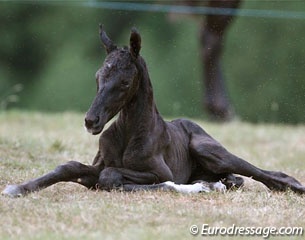
Researchers Meerburg, Van Dierendonck, Back, Van den Belt, Van Schaik, and Meeus of the Utrecht University has investigated that the relation between standing up behaviour of warmblood foals and the prevalence of osteochondrosis differs between farms.
Osteochondrosis (OC) is a common and clinically important joint disorder that is defined as a focal disturbance of enchondral ossification. The pathogenesis is multifactorial, but in most recent literature the failure of blood supply to the growing cartilage has been seen as a factor of major importance. Doubts about heritability of OC became clear when different joints appeared to be involved at different ages, so environmental factors are likely. Cartilage injury (with fragmentation) due to pressure changes when the leg slips, has been observed.
We tested the hypothesis that there is an association between the way of standing up in foals and the development of OC. We observed the standing up behavior of 36 warmblood foals at the age of 8 months at 5 different farms, with different housing / bedding. Foals were observed using surveillance tube cameras, and stored on VHS videotapes (3-4 hours/day; total 24 hrs per farm). We scored whether there was a normal stand up (NS) or a slipping limb (SL).
The standing up was scored by means of a predetermined ethogram. The incidence of OC was determined using a mobile x-ray machine and standard criteria (A=OC absent and B-E=OC present). In the preliminary results appeared to be a statistical difference between farms in the absolute number of NS observations/24 hr (mean±SD 3.4±2.5; P<0.05) and of SL/24 hr (mean±SD 1.8±2.3; P<0.05). The relative number of NS (% total registrations) varied on farms (mean±SD 73.1%±25.8%; P<0.05, n=5) as well as of SL (mean±SD 26.9%±25.8%; P<0.05, n=5).
There was also a difference between farms in relative prevalence of OC (range 12.5-27.4% of joints affected). When farms were divided into low (<15%, n=2), medium (15-25%, n=2) and high (>25%, n=1) OC risk, there appeared to be a significant difference in prevalence of SL (L: 17.6%, M: 24.6%, H: 47.4%; P<0.05); high OC risk farms had the highest %SL.
In conclusion, the environment seems to have a significant influence on the prevalence of OC, related to standing up behaviour and limbs sliding. There seems to be an opportunity for farms to decrease the prevalence of OC in their foals through preventing foal limbs sliding while standing up.
- ISES Conference abstract
Related Links
KWPN to Publish Osteochondrosis Results in January 2012
Osteochondrosis, a Growing Pain for Young Horses